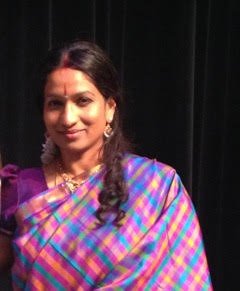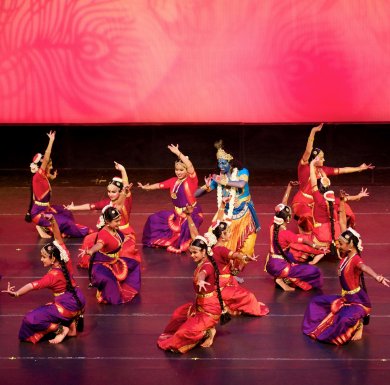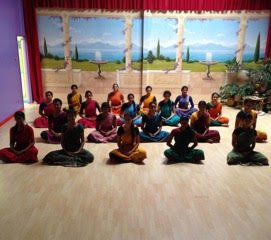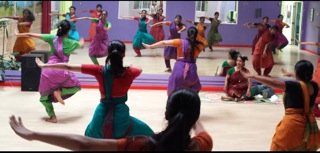
|
 |

|
 |
Sundara Swaminathan: 25 years of Kala Vandana - Poornima Ramaprasad e-mail: poornima-at-sbcglobal.net Photos: Kalavandana Dance Company July 16, 2015  Sundara Swaminathan, the founder and artistic director of Kala Vandana Dance Company is a well known exponent of Bharatanatyam. A graduate of Kalakshetra, Chennai, she was fortunate to be trained under Guru Rukmini Devi and other eminent teachers at Kalakshetra. Sundara's expressive eyes, graceful movements and precise footwork have gained acclaim for her both in India and in the USA. Besides being an excellent dancer, Sundara is an expert choreographer and a dedicated teacher who has influenced many of her students with her dance training and life lessons. She has presented many excellent productions to the Bay Area audience over the years - Shraddhanjali, A Child's world, Return to Tradition, Lord of Dance, Dasavataram, Glory of Muruga, Tales of Temple Dance and Gopika Krishna to name a few. She has done several fundraising events for notable causes as well. Here are excerpts from an exclusive one on one with Sundara Swaminathan.  What were your inspirations and aspirations that brought you to where you are today? When I started Kala Vandana Dance Center, I wanted to establish an institute that taught dance as a life education, and not just as a form of performing arts. I wanted every student to understand the meaning of hard work and discipline, to know the power of their potential and realize that there is no limit to what they can accomplish, that they could achieve and excel without competing. It brings tears of joy when I hear from alumni when they share with me how Kala Vandana has shaped their life beyond dance and the stage. Looking back in these 25 years, what's the most rewarding experience you've had? Having had the opportunity to teach this wonderful art to so many kids and see the profound influence it has in their lives is indeed a blessing. I am proud as well as humbled to see the great value my students attribute to their education at this school and how it has molded their lives. What is your stand on balancing tradition and innovation on dance? Bharatanatyam is a classical dance form. Expression of innovations, conforming to the classical form and traditional nature of this art is the key to balance the two. Is there a necessity to bring contemporary themes to dance to make it popular? In your thematic shows do you still believe in aligning them to the traditional repertoire? In my opinion, thematic programs present a cohesive concept or story through dance and music. Themes need not be always stories from mythology and that way they may not entirely adhere to traditional repertoire. Concepts or themes, such as nature, love, devotion or other emotions are eternal. But, contemporary themes that address popular social and political issues neither make Bharatanatyam popular nor raise awareness of the issues. Often, these programs are presented only to popularize the presenter and satisfy their ego! How does dance and Bharatanatyam in particular help in overall personality of an individual? Not all students of Bharatanatyam can become professional performers and choreographers. But I believe every student can be trained via Bharatanatyam to become a great performer of their own life, choreographing it as they wish. Can you talk about the right age, time, state of mind, continuity in the future, etc, that should play a role in doing the arangetram? There is no formula for arangetram qualification. A student's qualification and readiness to perform arangetram should be felt by and determined by the teacher. A student is not ready for an arangetram just because they have learned the repertoire, or they're graduating from high school, or that the parents wish to see their child do the arangetram. It is a subjective decision of the teacher. Respecting and abiding by that is also part of learning Bharatanatyam. Arangetram is neither the end nor the beginning of learning Bharatanatyam - it is an optional passage!  Given that you are yourself a good dancer, have you ever felt you should have become a performing artist rather than a teacher? Not really. I am a performing artist and I love performing, but being a teacher gives me not only great satisfaction as a performer, but it also gives me wonderful opportunities in presenting performances. As my guru says, "All good teachers are naturally very good dancers; but not all performing artists can teach. Being able to do both well is a blessing." How do you think a learner should integrate yoga and dance? Yoga was part of the curriculum at Kalakshetra. But more than yoga, I emphasize meditation, as it gives the energy, hope, and confidence one needs to exceed her or his own potential and expectations, especially in performing arangetram. Kala Vandana is one of the few institutions in the Bay area that impart the Kalakshetra type of training. How do you emulate the Kalakshetra experience at Kala Vandana? For me, Kalakshetra style is not just the adavu styles and movements, but it is a comprehensive concept with a core of spirituality, traditions and values. All these aspects are always emphasized in Kala Vandana in training and performances by the choice of music, lyrics, dress code, presentation and the arangetram format, classroom behavior, setting goals and expectations for the student and parents.  Do you think a dancer has to stick to one style of dancing or do you encourage your students to try out other forms of dance? Stick to only one style and learn it well before attempting other styles and forms of dance. Finally, what is your word of advice and word of caution to aspiring dancers? Always think, what is the purpose of your performing dance on a stage. It should not be for fame, glamour, competition, or for satisfying your ego. The purpose of learning and performing Bharatanatyam is not to show off oneself but to express the divine in the art form. Do not use dance to serve your ego. Poornima Ramaprasad follows Indian classical music and dance forms. She reviews Indian dance and drama events in the San Francisco Bay area from time to time. Post your comments Unless you wish to remain anonymous, please provide your name and email id when you use the Anonymous profile in the blog to post a comment. All appropriate comments posted with name & email id in the blog will also be featured in the site. |